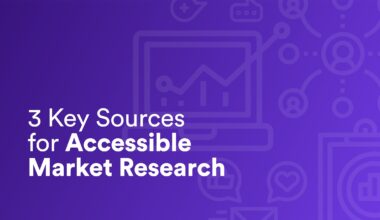Why empathy maps are more important than ever
Let’s be frank: the last two years have been rough, to say the least. We’ve lost school days, social outings, businesses, sanity, and most of all, people. Our collective mental health is at an extreme low, even as things have shifted to “normal.”
And when I say we, I do mean we. We are marketers second to being humans who have been in the same storm as our customers. Imagine how your emotions have risen and fallen along your journey over the last couple of years:
- Scrubbing your delivered groceries 😨
- Transitioning to being a homebody 🧘
- Delightfully watching cringey TikToks (and secretly loving them) for the distraction and now just out of habit 🤪
- Joyfully booking tickets for the first IRL concert since pre-pandemic 🥳
- Trying (and failing—maybe?) to figure out what an NFT is 🤯
- And so much more!
Those emotions, while not entirely connected, look something like a curvy line with highs, lows and everything in between, which is a great transition to our topic: empathy maps.
The importance of empathy mapping
It may seem callous to shift focus from talk of the pandemic to empathy maps used for marketing and UX purposes, but let me explain. That’s the point of empathy: the ability to understand and share the feelings of another. And without acknowledging all the changes over the last two years, companies are likely using outdated information to guide their marketing decisions. Because we know WE’VE changed, so why wouldn’t that mean our customers have too?
According to Salesforce, 68% of customers expect brands to demonstrate empathy, but just 37% say they actually experience it. Understanding your customers’ mindsets as they begin and end a purchase journey can do more than just bring clarity to their thoughts and actions—it can provide the structure you need to revamp marketing and website strategies—and differentiate you from your competitors who likely aren’t delivering the same.
How to approach empathy map development
- First, while it’s not completely necessary, having a good understanding of the critical touchpoints of a customer journey adds to the foundational work of an empathy map and creates a holistic picture.
- Next, you need to talk to your customers. Voice of customer sessions (read, plural) are an important activity to truly comprehend what they’re feeling during a purchase cycle, what they’re asking themselves, seeing, hearing, and what their pains and gains are.
- Find commonalities amongst your customers, such as the questions they’re asking themselves while searching for a solution or what issues or blockers arise during the search for information.
- Start to document your empathy map. Emojis are optional, but recommended (so fun).
So let’s put this into action by taking the above activity of our homebody buying concert tickets and craft what a hypothetical empathy map could look like now. And the situation is important: in late 2021, scalpers and bots scooped up a huge chunk of Olivia Rodrigo’s SOUR tour tickets, despite Ticket Master’s attempts to thwart them with a “Verified Fan” lottery. It left her fans with a very sour taste in their mouths (I’m sorry, I had to.) And other concert-goers were left to wonder “Will this happen to me?”
Think / Feel: I’ve been watching music specials on my streaming services like Disney+ and HBO Max, and it made me realize I’ve missed out on live music for the last 2 years.
Hanson note: Note here that streaming services have a way of influencing actions. Our music-lover isn’t suggesting replacing the services with a concert, but appending to her entertainment choices. Consider these services as a potential touchpoint.
Hear / See: I’ve read in the news about how scalpers and bots have made buying concert tickets worse, even despite laws passed to protect consumers. I’m not sure I can trust the process, and I don’t want to be let down.
Hanson note: Already we are getting a sense of their weariness and the mentality of “is it even worth it to try.” The action for ticket retailers is making the selling process easier, seamless, and more trustworthy.
Say / Do: “There are way too many websites to buy concert tickets, and I have no idea what’s truly reputable or not—and still within my budget.”
Hanson note: As consumers, we tend to place too much value and trust on the first SERP. In this instance, our concert-goer is simply not educated on what is safe. Educating potential customers on secure concert ticket sites (they feature a lock symbol in the URL) could go far, as well as other tactics discussed below.
Pain: Concerned about the cutthroat act of buying reasonably priced tickets—and how many fraudulent seller sites there are these days.
Gain: Assured that with privacy policies and the right search tactics, they’ll find a reputable site to purchase tickets from.
Hanson note: There are ways around these pains and gains, like encouraging fans to sign up for email alerts, creating accounts for easier access to tickets, and more. But from this map, you can get an idea of the disheartened mood that has settled in for this consumer, even as they set out to buy something that will bring entertainment.
Hopefully, this exercise in empathy mapping was helpful for a refocused emphasis on empathy as we venture further into 2022 and beyond. As stated in the beginning, we are all human beings at the end of the day—let’s lean into understanding each other on all levels.





